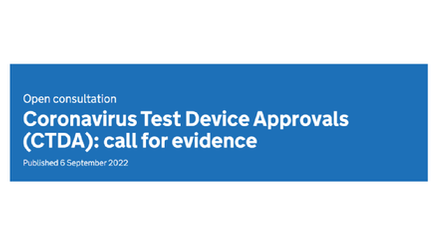Statement on SARS-CoV-2 Testing Options
This statement aims to support scientists and other laboratory professionals in selecting and advising on the most appropriate testing route for patients. The information is based on known clinical need, the requirement to support the management of patients within different care settings, and the limited supply of rapid testing kits.
Background Context
In early August 2020, the UK government announced two new rapid SARS-CoV-2 tests. Capable of delivering a result in 90 minutes, they are due to be made available in accredited NHS laboratories, lighthouse laboratories and care homes. However, these tests are not the silver bullets in the coronavirus response, they are only one part of the armoury. The most important aspect of laboratory medicine is the diagnostic testing pathway which includes the end to end process consisting of:
- correctly identifying those who need testing
- obtaining appropriate samples from the correct patient
- producing results in a timely manner
- making the results available to the clinical decision maker
- interpreting the results and taking the appropriate action
The goal of all high quality medical laboratory services can be summarised as; ensuring the right test, for the right patient, at the right time, and giving the ‘right’ result to inform the right response.
Access to rapid testing in the UK will support individuals and communities and complement the national COVID-19 testing strategy for PCR testing across NHS and lighthouse laboratories, but will not be the solution.
There is a clear need for biomedical scientists and clinical scientists to provide advice to clinical teams on the appropriate use of the range of tests currently available, including these rapid tests. All diagnostic tests have limitations and it is fundamental to patient safety that all those involved in clinical decision making are aware of them.
Testing Options
1. Rapid testing
Test definition
Rapid testing is defined as an analytical test performed for a patient by a healthcare professional with a short delivery time to results (less than 4 hours).
Where it is carried out
Rapid testing may be carried out as a point of care/near patient test.
Due to the complex nature of the testing process, it is more likely that this rapid testing is carried out in a laboratory setting and supervised by Health and Care Professions Council (HCPC) registered biomedical or clinical scientists.
Clinical requirement: Current priorities for rapid testing are to enable the acute management of patients and clinical services where only the use of rapid testing will facilitate better patient care.
Rapid testing devices are currently available to healthcare providers on a limited scale and have been unable and are unlikely to meet testing demand in this setting. It is therefore vital that rapid tests are only used where there is no other clinically acceptable alternative.
As supply increases there may be a role for rapid testing in situations where a fast turnaround is beneficial such as managing an outbreak in a community setting, but only if the test is suitably validated for the patient cohort being tested.
Instrumentation
Rapid testing utilises qualitative or semi-quantitative in vitro diagnostics (IVDs), used singly or in a small series which involve non-automated procedures. They have been designed to give a ‘rapid’ result and can deliver SARS-CoV-2 direct viral test results from a swab sample, usually within 90-120 minutes. Where the device is sited close to the point of swab collection, a rapid result can be obtained for an individual patient.
Advantages
Results may be available near to the point of patient care and may support rapid patient triage. This can assist hospitals in managing emergency departments and other acute services to support bed availability and efficient patient flow. Multiple instruments can be linked so that a set of instruments can provide small scale throughput.
A laboratory may not need to be on the same site as the rapid testing device, depending upon the processes involved in the testing. Conditional upon the patient cohort and testing platform being used, these devices may provide sufficient result sensitivity to not require confirmation by a laboratory test. However, there will remain a need to repeat equivocal positive, potential false negative, and potential false positive results as deemed clinically appropriate.
Disadvantages
Speed of reporting is countered with the compromise of limited test processing capacity and is dependent upon the platform used. Capacity can be as low as 9 tests or as high as 138 test per day on a 24-hour operating schedule. This is compounded by a number of systems only being able to process samples one at a time.
Rapid testing devices are not enabled with automated loading and require a trained healthcare professional to operate the equipment, often with multiple interventions. A lack of result interpretation, that would normally be undertaken by HCPC registered scientists before result issue, may also result in a failure to detect erroneous results.
Unfortunately, the performance characteristics of these new assays cannot always be assured, resulting in some of the faster instruments requiring equivocal results to be rechecked by a different method before diagnosis can be made. This defeats the point of rapid testing. These tests often have significantly lower testing sensitivity than laboratory-based platforms meaning they have the potential to miss weak positive patients. This is a significant risk, particularly if this test is being used to triage patients to COVID-19 and non-COVID-19 areas of a hospital.
The equipment directions for use must also be carefully scrutinised to ensure that the platform is only being used for the purposes that it has been validated for. Some systems are only recommended for symptomatic patients, while others have not specified, meaning a validation on its clinical performance that is relevant to the patient cohort to be tested should be undertaken by the testing centre before implemented into routine use.
Results often need to be manually linked to the patient health record as these platforms do not generally allow electronic transmission of data to patient files. This may also present challenges with the reporting of results to the NHS and appropriate public health bodies.
The absence of economies of scale means that decentralised rapid testing can be prohibitively expensive (reports of £140 per test for reagents only), especially when compared to large scale laboratory testing (typically £20 per test for reagents). Rapid testing is the most expensive modality of testing.
Rapid testing devices are currently available to healthcare providers on a limited scale – this falls short of expected testing demand. It is therefore vital rapid tests are only used where there is a clinical requirement.
Staffing requirement
Rapid testing is labour intensive due to the need for numerous interventions during the testing process and the need to operate multiple instruments.
Rapid testing instruments should be operated by suitably trained members of staff and require the oversight of an accredited laboratory to ensure the instrument is appropriately evaluated and validated prior to use. Devices should be regularly maintained and properly calibrated by qualified scientific staff to ensure reliability and consistency of results.
Summary
- Rapid testing is not a replacement for the laboratory based PCR test.
- It must only be used in the patient context that it has been approved and validated to undertake
- These tests often have a low level of sensitivity
- It should be used only where it is clinically appropriate to improve patient outcomes and no equivalent laboratory alternative is available
- Rapid testing is the most expensive modality of testing.
- Rapid testing is labour intensive per sample processed when compared to traditional laboratory testing.
- Systems and processes must be in place to ensure that results are physically linked to the patient health record – these often require manual interventions.
Clinicians and laboratory professionals must work together to ensure rapid testing is managed and used appropriately for the patient and wider healthcare systems benefit.
2. Medical laboratory high throughput RT-PCR testing
Test definition
This is the most widespread form of testing nationally, where swab samples are processed using automated or semi-automated instruments. This is also an area where constant innovation is improving the testing pathway. For example, a study is underway to validate tests that use a saliva sample rather than a nose/throat swab.
Where it is carried out
PCR testing is carried out in accredited NHS laboratories, usually hospital based, or other laboratories and should be overseen by a team of competent HCPC registered biomedical scientists and/or clinical scientists.
Clinical requirement
It is used for testing patients, NHS staff and social care workers. It is typically the preferred test, due to its sensitivity (ability to detect weak positives), for patients before elective operations and invasive procedures. Symptomatic patients may require further testing as the differential diagnosis between COVID-19 and other respiratory infections may not be initially clear. It can also be used to manage local outbreaks, and targeted testing to prevent nosocomial infections. This is due to its suitability to large scale testing over a clinically acceptable timeframe. Results are typically delivered within 15-24 hours back to the hospital or the requesting clinician.
Instrumentation
Samples are processed on highly automated or semi-automated platforms that are capable of undertaking a high volume of workload per day. Testing capacity can be further increased through 24-7 working arrangements, or further automation of the laboratory process. This can often be undertaken with minimal increases in staffing.
Advantages
Results should be available within 15 hours. Results are transferred directly into the patient’s healthcare records (usually electronically) providing clinicians and public health teams reliable access to all the information they need. Results are available with the complete patient record supporting safe patient care.
Thousands of results can be available quickly and efficiently supporting hospitals to return to ‘business as usual’ and re-instate routine services such as cancer and surgical services that have built up backlogs of planned care, due to suspension of surgery during the height of the pandemic.
Results are provided in a high quality, clinically controlled environment, by qualified and registered staff who we expect to be working to stringent international quality standards.
These assays are typically very sensitive meaning they are able to detect the vast majority of ‘positive’ patients. This is especially important when testing those with a low viral load, such as asymptomatic patients and those in the early stages of infection.
Disadvantages
Routine high throughput RT-PCR is provided by hospital laboratories that are undertaking a very large range of other diagnostic tests. Laboratories will prioritise clinically urgent patients over routine services and, in rare circumstances, this may delay some testing.
There may be delays associated with transporting samples to laboratories. However, there will be no delay in reporting the result where it is electronically logged in the patient record.
There is a risk that the current level of laboratory testing capacity will be constricted as ‘routine workloads’ continue to return, as hospital services that have been suspended start to be reinstated.
Staffing requirement
Laboratories carrying out these tests are staffed by scientific and support staff. The IBMS would expect that these staff consist of HCPC registered biomedical and/or clinical scientists to oversee the service. There may be a requirement for additional staff should the service be required to support 24/7 working, increased testing volumes or the requirement to make the enhanced service a permanent arrangement rather than a temporary ‘surge’ response.
Summary
- Routine high throughput PCR testing is the primary resource of hospital-based testing
- This testing is highly sensitive and has been validated for use in a wide range of clinical scenarios
- This testing is laboratory based, often highly automated and typically operates in an accredited environment
- This form of testing provides results in a timely manner for the majority of clinical situations and is cost effective
- The testing is undertaken by highly qualified staff and supervised by HCPC registered scientists
- This testing can often be upscaled with limited amounts of additional staffing
- Robust systems are in place for results to be linked with patient health records
- High quality, comprehensive data is available to public health officials when required. Laboratory based testing is the ‘usual’ route for healthcare professionals so there is a high level of confidence in the quality of the results and testing service provided.
3. Centralised mass testing
Test definition
Mass testing provides testing for screening purposes in the wider population.
Swabs are collected at sampling centres from symptomatic and asymptomatic individuals.
Where it is carried out
Samples are processed on a large scale in a laboratory setting which enables thousands of tests to be processed each day.
Clinical requirement
These services are used for large scale community screening and care home resident testing. Results for these samples are expected to be reported within 24 hours.
Instrumentation
Testing is processed on highly automated platforms that are capable of undertaking a high volume of workload. These services typically function 24-7 to support testing from a wide geographical area.
Advantages
Very large volumes of samples can be undertaken. This is through the use of highly automated processes that allow a small number of large laboratories to receive samples from swabbing stations across the country, including ‘pop-up’ sites.
These testing facilities only focus on screening for SARS-CoV-2 so are not impacted by the need to process other tests.
Individuals showing symptoms can access a test on-line and receive their result directly to their phone or email, with an expected turnaround of 24 hours.
Disadvantages
There are potential issues with sample integrity due to variable consistency from both self-sampling and pop-up stations.
Data sets need to be returned to multiple parties including the individual, the GP and public health, and it has widely been reported that these centres have experienced issues with the flow of this data, particularly during the early phase of the pandemic.
The limited data sets collected from the patient also mean that insufficient data is often available to public health officials to assist in local public health initiatives (e.g. workplace outbreaks).
Due to the scale of the testing operations any failures in the system can cause a delay upon many thousands of sample results being available in a timely manner.
These new services have been stood up rapidly and therefore may have issues with long term sustainability and business continuity.
These services have often not been ‘kite marked’ by recognised laboratory medicine accreditation.
Staffing requirement
These laboratories are staffed by a combination of academic, scientific and support staff. It is unclear on the levels of HCPC registered biomedical scientists and/or clinical scientists that are currently involved in these services. The IBMS expect sufficient HCPC registered staff to be employed to provide adequate supervision of non-registered staff to provide a safe service. These laboratories operate on a 24-7 basis and must be safely staffed to allow this intensity of test processing.
Summary
- Capacity to process very high volume testing for population screening purposes
- Have the infrastructure to provide results direct to the patient via text or email
- This testing is laboratory based and highly automated
- This form of testing typically provides results in a timely manner for the patient cohort being tested
- Do not collect sufficient data to provide public health bodies with all the information they need
- The ability for these services to link result with patient health records is unknown and likely to be limited.
Conclusion
Despite the wide publicity that ‘rapid testing’ has received in the press it is only a small part of the national response to fighting COVID-19. There will need to be an integrated use of all three forms of testing outlined above.
Rapid testing should only be utilised when results are clinically required quicker than can be provided by a traditional laboratory-based system. This is due to a lack of testing capacity, limited availability of platforms and reagents, significant expense of testing and the limitations of the tests (i.e. risk of incorrect results). It is paramount for patient safety that these tests are only used in the clinical scenarios approved by the manufacturer and local validation. It must not be assumed that these systems are appropriate for testing in all patient cohorts.
Routine high throughput RT-PCR testing is the backbone of testing for hospital patients, NHS and social care staff. It is also useful for local public health testing initiatives. These are high throughput, high quality services that utilise tests sensitive enough for the vast majority of clinical situations. These are cost effective and adaptable operations that provide timely results. Primary and secondary healthcare professionals have high confidence in the services that they provide.
Mass screening services are designed solely for largescale population screening. These are large scale single test services that have the ability to provide results directly back to the patient, and receive samples from a wide geographical area. Use of these services allows the hospital laboratories to focus on immediate patient care needs for their local populations.





